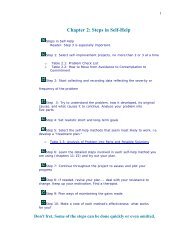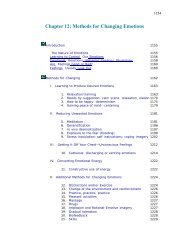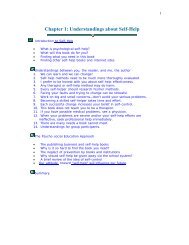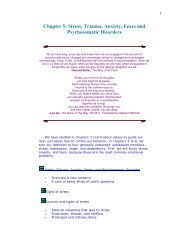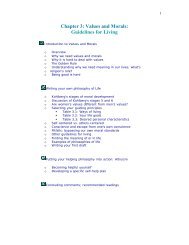Methods for Changing Behaviors - Psychological Self-Help
Methods for Changing Behaviors - Psychological Self-Help
Methods for Changing Behaviors - Psychological Self-Help
You also want an ePaper? Increase the reach of your titles
YUMPU automatically turns print PDFs into web optimized ePapers that Google loves.
See chapter 2, step 2.<br />
STEP THREE: Make a chart of your progress.<br />
The daily counts or ratings can be plotted on a weekly or monthly<br />
chart, as illustrated in chapter 2. Both counting and charting are easy<br />
to <strong>for</strong>get; try doing them at scheduled times or pair them with some<br />
dependable event. Examples: count calories be<strong>for</strong>e each meal; plot<br />
daily total calories be<strong>for</strong>e doing exercises every evening; rate "target"<br />
emotion be<strong>for</strong>e having your evening drink; plot hours spent studying<br />
effectively every night be<strong>for</strong>e going to bed.<br />
STEP FOUR: Use progress chart as a motivator; set reasonable<br />
immediate, intermediate and final goals.<br />
"Taking one small step at a time" or "one day at a time" is good<br />
advice. Long-range goals may seem overwhelming, but a reasonable<br />
goal set <strong>for</strong> the next 15 minutes, the next hour, this afternoon, or<br />
today may seem quite manageable. For dieters, <strong>for</strong> example, focusing<br />
on self-control during the next few hours is more effective than setting<br />
weekly or monthly goals. Indeed, setting your own immediate goals<br />
which will enable you to reach your long-range goals, in terms of the<br />
"target" behavior, may be one of the better techniques <strong>for</strong> facilitating<br />
change (Chapman & Jeffrey, 1978). Completing the desired behavior is<br />
even more likely if you are frequently recording your progress; you<br />
need to be striving <strong>for</strong> some immediate goal as well as improvement<br />
each day or each week. The records will tell you if you made your<br />
goals. See chapter 2, step 4.<br />
Post the progress chart in a conspicuous place, over your "study"<br />
chair or "depression" chair, on the refrigerator door, near where you<br />
exercise, some place where others can see your progress too.<br />
STEP FIVE: Frequently evaluate your progress by comparing<br />
achievements with baseline data and with sub-goals.<br />
See step 7 in chapter 2. The concept of baseline data is explained<br />
there. The self-rewards and praise (or punishment and self-criticism)<br />
we give ourselves have a powerful effect upon our behavior.<br />
STEP SIX: Note special events on the progress chart.<br />
Of particular interest to record will be (l) possible causal factors<br />
and (2) major outcomes. First, any event that might help explain a<br />
change in your target behavior should be recorded: got a new job,<br />
started dating steadily, had argument with my boss, doing poorly in<br />
math, and so on. Second, as chapter 2 recommends, one would<br />
ordinarily record each day the most immediate and direct indicators of<br />
progress, e.g. calories consumed, hours studying each day, minutes<br />
involved in meaningful conversation with spouse, a rating of daily<br />
tension, etc. However, it is the big, long-range achievements that are<br />
1099



